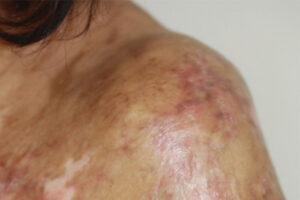Oncology
Chronic Graft-versus-Host Disease
Patients With Ongoing Chronic Graft-versus-Host Disease: Tracking and Adjusting Treatment
Overview
The ongoing clinical assessment of chronic graft-versus-host disease (cGVHD) includes objective measures of severity and a consideration of the toxicity/tolerability of treatment. The patient’s subjective experience, including the impact of any residual cGVHD symptoms, is also a crucial consideration.
Expert Commentary
Daniel R. Couriel, MD, MS
|
|
“We have a number of objective measures in cGVHD, but there is also a very important subjective component in the response assessment. What may be an acceptable response to one patient is not necessarily acceptable to another.”
The primary approach to follow-up is clinical because we do not yet have biomarkers that can reliably predict the risk and severity of cGVHD, nor do we have biomarkers to predict therapeutic responses with particular agents. In practice, we follow the National Institutes of Health consensus recommendations for the definition of disease progression and the assessment of treatment response. Important aspects of follow-up include the clinical assessment of cGVHD severity, and we also regularly weigh in the toxicities, or tolerability, of the therapy. Another aspect that is a bit more difficult to determine is predicting the chance of relapse. These patients do relapse, although those with mild forms of cGVHD relapse less frequently.
As relates to monitoring the affected organs, the majority of cGVHD is cutaneous and/or mucosal, predominantly affecting the skin, eyes, and mouth. Certainly, the liver, lungs, and other organs can also be affected. Since the monitoring is clinical, with the organ-based assessments in cGVHD, you tend to follow those organs that are already known to be clinically affected; however, certain events can bring a particular organ to the forefront (eg, a viral respiratory tract infection in a patient with lung cGVHD).
It is possible for an organ to worsen while another organ is being treated. You could have certain types of visceral involvement that seem to have a mind of their own, such as lung cGVHD, and you might see an improvement of the cutaneous mucosal manifestations if the patient has them but a worsening of the lung cGVHD; however, there tends to be some symmetry. When manifestations are cutaneous and mucosal, as they generally are, the response is usually symmetric across organs, so you often observe an improvement in each of those cutaneous/mucosal manifestations.
We have a number of objective measures in cGVHD, but there is also a very important subjective component in the response assessment. What may be an acceptable response to one patient is not necessarily acceptable to another. In many cases, treatment is titered based on the patient’s experience because, ultimately, your goal is to have a patient who is reasonably content with the way things are going. That is, sometimes you do not completely resolve every single symptom of cGVHD, but rather you get to a point where the individual can live with that degree of cGVHD. This variability is one of the challenges that can occur in interpreting the literature. So, that subjective aspect adds to the complexity, and it is a very important component in cGVHD assessment and monitoring.
References
Inamoto Y, Lee SJ, Onstad LE, et al. Refined National Institutes of Health response algorithm for chronic graft-versus-host disease in joints and fascia. Blood Adv. 2020;4(1):40-46. doi:10.1182/bloodadvances.2019000918
Martin PJ, Storer BE, Palmer J, et al. Organ changes associated with provider-assessed responses in patients with chronic graft-versus-host disease. Biol Blood Marrow Transplant. 2019;25(9):1869-1874. doi:10.1016/j.bbmt.2019.05.008
Radojcic V, Lee CJ, Couriel DR. Multifaceted burden of chronic graft-versus-host disease. Biol Blood Marrow Transplant. 2018;24(9):1774-1775. doi:10.1016/j.bbmt.2018.07.012
Yalniz FF, Murad MH, Lee SJ, et al. Steroid refractory chronic graft-versus-host disease: cost-effectiveness analysis. Biol Blood Marrow Transplant. 2018;24(9):1920-1927. doi:10.1016/j.bbmt.2018.03.008











